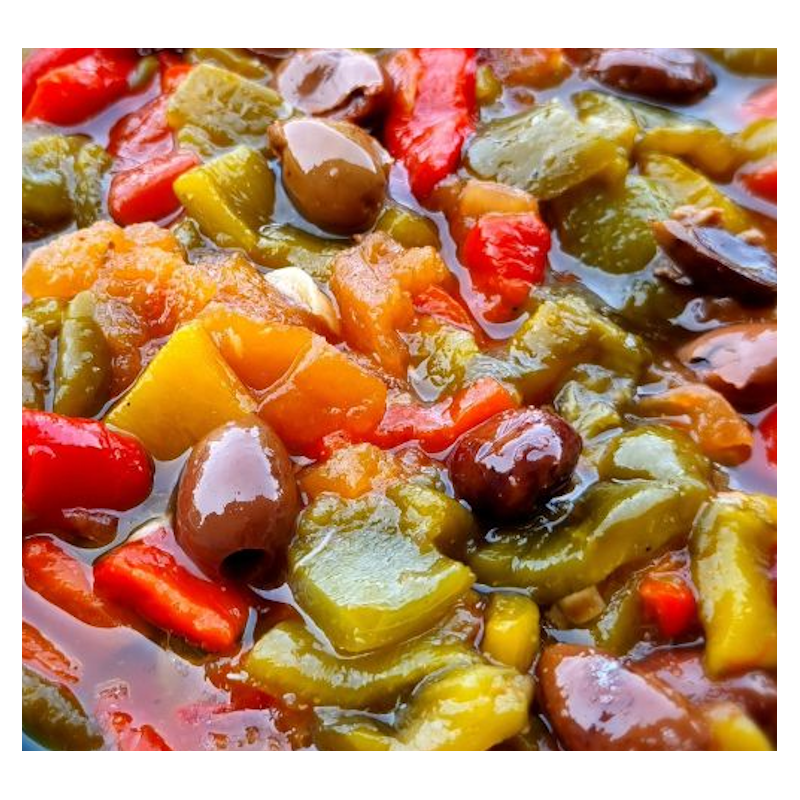Slata méchouia (Tunisian salad)
 Garanties sécurité
Garanties sécurité
(à modifier dans le module "Réassurance")
 Politique de livraison
Politique de livraison
(à modifier dans le module "Réassurance")
 Politique retours
Politique retours
(à modifier dans le module "Réassurance")
Recipe for Slata Méchouia (Tunisian Salad)
Slata Méchouia is one of the most popular and traditional dishes in Tunisian cuisine, representing the authenticity and richness of the country's flavors. It is often served as a starter or side dish and is especially appreciated during the warmer months, as it is both refreshing and full of character thanks to its grilled vegetables and fragrant spices.
Ingredients:
- Tomatoes – طماطم (Tamatim): 2 ripe tomatoes, cut into small pieces
- Grilled peppers – فلفل مشوي (Filfil Mashwi): 2 peppers, preferably red or green, grilled and peeled, then chopped
- Grilled chili peppers – فلفل حار مشوي (Filfil Har Mashwi): 1–2 chili peppers (depending on your tolerance to heat), grilled and chopped
- Grilled chopped onions – بصل مشوي مفروم (Basal Mashwi Mafroum): 1 medium onion, grilled and finely chopped
- Black olives – زيتون أسود (Zaytoun Aswad): 8–10 pitted black olives, chopped
- Ground coriander – كزبرة مطحونة (Kozbara Mat'hoona): 1 teaspoon
- Ground caraway – كمون مطحون (Kammoun Mat'hoon): 1 teaspoon
- Olive oil – زيت الزيتون (Zayt al-Zaytoun): 3–4 tablespoons
- Lemon juice – عصير ليمون (Aseer Laymoun): 1–2 tablespoons (depending on your preference)
- Garlic – ثوم (Thoum): 2–3 garlic cloves, finely chopped or crushed
- Salt – ملح (Milh): to taste
- Pepper – فلفل (Filfil): to taste
Instructions:
-
Prepare the vegetables:
- Grill the vegetables: Place the peppers and chili peppers on the grill or directly over a flame until the skin is charred. You can also grill them in a dry pan. Once grilled, place them in a plastic bag or covered bowl for a few minutes to make it easier to peel off the skin. Then, peel the skin off the peppers and chilies and chop them into pieces. Grill the onions until well caramelized and finely chop them.
- Cut the tomatoes: Cut the tomatoes into small pieces.
-
Prepare the garlic: Finely chop or crush the garlic using a mortar and pestle.
-
Mix the ingredients: In a large bowl, combine the tomatoes, grilled peppers, grilled chilies, grilled onions, and chopped black olives.
-
Season the salad:
- Add the ground coriander, ground caraway, salt, and pepper to taste.
- Squeeze the lemon juice over the vegetables and drizzle with olive oil.
- Add the chopped garlic and mix well so that all the ingredients are evenly coated with the dressing.
-
Taste and adjust: Taste the salad and adjust the seasoning if necessary by adding more salt, pepper, or lemon juice according to your preference.
-
Serve: Slata Méchouia can be served immediately or kept in the refrigerator for a few hours to let the flavors blend better. It can be served cold or at room temperature, ideally accompanied by fresh bread or pita.
Additional tips:
- If you like spicier salads, feel free to add more grilled chili peppers.
- Slata Méchouia can be served with canned tuna or hard-boiled eggs, adding more substance to the dish.
- For a creamier version, you can add a little plain yogurt or mayonnaise to the salad.
This Tunisian salad is a true burst of Mediterranean flavors, perfect for a light summer meal or as a side dish to more hearty meals. Bon appétit, or as they say in Arabic: بصحتين (Bseha w'Afya)!
Ingredients Breakdown:
Each ingredient in the Slata Méchouia has a particular significance and history, not only in terms of flavor but also in culture and tradition. Here's a look at each ingredient with its name in Arabic and its origin:
-
Tomatoes – طماطم (Tamatim)
- Origin: The tomato, an emblematic fruit of Mediterranean cuisine, has been cultivated in the region for centuries. It arrived in North Africa after being discovered by the Spanish in the 16th century.
- History: Once considered a typically Mediterranean fruit, tomatoes are now indispensable in dishes across the Maghreb for their rich flavor and vibrant color.
- Tradition: In this salad, it adds a touch of sweetness and acidity, balancing the more intense flavors of the other ingredients.
-
Grilled peppers – فلفل مشوي (Filfil Mashwi)
- Origin: Peppers are native to the Americas, but they are widely grown in North Africa, where they are used in many traditional dishes.
- History: Grilled peppers, with their slightly charred skin, add a smoky depth of flavor to the salad. They are a central element in Tunisian cuisine, present in dishes like couscous and tagines.
- Tradition: Grilled peppers bring a sweet, smoky taste, typical of Mediterranean cuisine.
-
Grilled chili peppers – فلفل حار مشوي (Filfil Har Mashwi)
- Origin: Like the bell pepper, chili peppers are native to the Americas. They were introduced to Africa after trade exchanges and quickly became integral to Tunisian cooking.
- History: Chilis are used in Tunisian cuisine for their heat and ability to enhance flavors. Grilled chili peppers in this salad add a spicy kick, typical of the heat and intensity of Tunisian dishes.
- Tradition: Grilled chili offers a subtle warmth that blends perfectly with the sweetness of the other vegetables.
-
Grilled chopped onions – بصل مشوي مفروم (Basal Mashwi Mafroum)
- Origin: Onions have been cultivated since antiquity and are a staple ingredient in nearly every cuisine, including Tunisian cuisine.
- History: Besides adding crunch, onions also bring natural sweetness once grilled, making them a key ingredient in Slata Méchouia.
- Tradition: The grilled onion in this salad introduces a milder, caramelized taste, providing a pleasant contrast to the other ingredients.
-
Black olives – زيتون أسود (Zaytoun Aswad)
- Origin: Olives are an essential part of Mediterranean culture, grown primarily in the Maghreb regions, including Tunisia, where they are used in many forms, from oil to whole olives.
- History: Black olives have a long history in Tunisia, being a staple that accompanies almost every meal. Their intense, salty flavor perfectly complements the grilled vegetables.
- Tradition: The black olive in Slata Méchouia adds a salty, slightly bitter taste that enhances the overall profile of the salad.
-
Ground coriander – كزبرة مطحونة (Kozbara Mat'hoona)
- Origin: Coriander, native to Asia and the Mediterranean, is widely used in Tunisian cooking, often in ground seed form.
- History: Ground coriander is used for its citrusy, spicy flavor. It is a key ingredient in many Tunisian dishes, including tagines and sauces.
- Tradition: In Slata Méchouia, it adds a fresh, slightly spicy note that complements the other salad flavors.
-
Ground caraway – كمون مطحون (Kammoun Mat'hoon)
- Origin: Caraway is a highly prized spice in North Africa, especially Tunisia, where it is commonly used in salads and meat dishes.
- History: Caraway has a warm, slightly aniseed flavor and is widely used to aid digestion after hearty meals. It plays a fundamental role in Tunisian cuisine, often added to dishes to elevate flavors.
- Tradition: The ground caraway in this salad brings a subtly spicy touch, very characteristic of Tunisian cuisine.
-
Olive oil – زيت الزيتون (Zayt al-Zaytoun)
- Origin: Olive oil is central to Mediterranean and Tunisian cuisine, cultivated in regions like Cap Bon, known for its exceptional olive oil production.
- History: Tunisian olive oil is considered some of the best in the world, renowned for its fruity taste and richness. It is used in a variety of dishes, including this salad.
- Tradition: Olive oil is a fundamental ingredient that helps bind all the other ingredients together while adding richness and smoothness.
-
Lemon juice – عصير ليمون (Aseer Laymoun)
- Origin: Lemons are widely grown in Mediterranean regions, and their juice is highly prized in Tunisian cuisine to add acidity and freshness.
- History: Lemons were introduced to the region by the Romans and have since become an essential product in Tunisian salads, meats, and desserts.
- Tradition: In Slata Méchouia, lemon juice provides a welcome acidity that perfectly balances the rich, spicy flavors.
-
Garlic – ثوم (Thoum)
- Origin: Garlic is grown throughout the Mediterranean region and is an essential part of Tunisian cooking.
- History: Garlic is used in cooking for its ability to add depth of flavor and a slight pungency. In Slata Méchouia, garlic plays a key role by bringing warmth and intensity.
- Tradition: Garlic is used not only for flavor but also for its health benefits, especially its immune-boosting properties.
-
Salt – ملح (Milh)
- Origin: Salt is a fundamental part of every cuisine worldwide. In Tunisia, sea salt is used to enhance the flavor of dishes.
- History: Salt has a long history and has been used since antiquity for food preservation and to bring out the flavor.
- Tradition: Salt in Slata Méchouia is used to accentuate the natural flavors of the grilled vegetables.
-
Pepper – فلفل (Filfil)
- Origin: Pepper is a spice native to India but has become a staple in cuisines worldwide, including Tunisia.
- History: Pepper is used in Tunisian cuisine to add heat and warmth, often paired with spicy, aromatic dishes.
- Tradition: Pepper in this salad balances the other spices and adds a light, zesty kick.
Conclusion:
Slata Méchouia is a reflection of the flavors and culinary traditions of Tunisia, where simple ingredients rich in history come together to create a refreshing and delicious dish. Each ingredient carries with it an ancient story and a deep connection to Tunisian culture and land.


